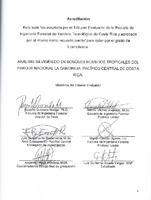Análisis Silvigénico de los Bosques Húmedos Tropicales del Parque Nacional La Cangreja, Pacífico Central de Costa Rica
Abstract
Information
from six sites with long
-
term monitoring plots at La Cangreja National
Park, Central Pacific of Costa Rica, monitored by 13 years of (1998
-
2011) was
analyzed to determine the forest ́s sylvigenetic development. On 2011, averages
values to the forest were an
nual mortality 1,88±0,62% , annual recruitment
1,5±0,34%, N/ha 555±52 and G/ha 39,6±6,0 m
2
/ha. Correspondence, cluster and
SHE Analysis determined that there are 3 kinds of forest on the six sites studied. a.)
Logged forest: on Phase III dynamic of
Sylvigenesis; G 38,2 m
2
/ha, N/ha 560, heigh
t
34 m, annual mortality 2,05%,
annual recruitment 1,41%. In the future, there is
expected that this forest keeps the actual structure and floristic composition. b.)
Mature secondary forest: on Phase III homeostat
ic of Sylvigenesis; G 53,01 m
2
/ha,
N/ha 568, height 31,4 m, annual mortality1,2%, annual recruitment 1,76%..The future
of this forest will depend of
Ficus insipida
mortality. If they die and decomposed
standing up, it would give the chance to saplings and
low diameter class to close the
gaps, but if they were fallen by winds or landslide, the gaps size would be bigger and
Sylvigenesis will go back to the Phase II or Phase I. c.) Intermediate maturity of
secondary forest: on Phase III dynamic of Sylvigenesis
G 31
,
75 m
2
, N/ha 522, height
29,4 m, annual mortality 1,88%, annual recruitment 1,64%. In the future there is
expected that pioneer species would continue diying, and gaps will be closed by the
established regeneration of partial tolerant shade species in
to low diameter class.
Description
Proyecto de Graduación (Licenciatura en Ingeniería Forestal). Instituto Tecnológico de Costa Rica, Escuela de Ingeniería Forestal, 2011.


